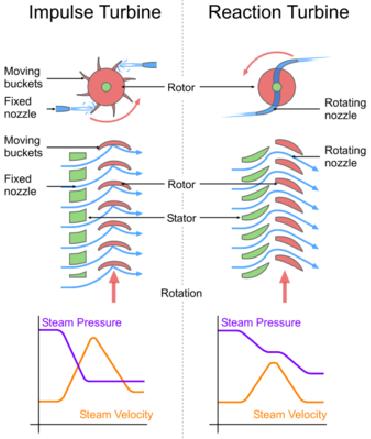is a device that converts the force of a gas or liquid
moving across a set of rotor and fixed blades into motion. There are three
basic types of turbines: gas, steam, and hydraulic. Gas turbines are
powered by the expansion of compressed gases generated by the combustion of
a fuel. (See internal combustion
engine). Some of the power thus produced is used to drive an air
compressor, which provides the air necessary
for combustion of the fuel. In a
turbo-jet aircraft engine, the turbine’s only function is to drive the
compressor: the plane is propelled by the force of the expanding gases
escaping from the rear of the engine. In other applications, however, the
rotor shaft provides the driving thrust to some other mechanism, such as a
propeller or generator. Thus, gas turbines power not only turbo-jet
aircraft, but also turbo-prop aircraft, locomotives, ships, compressors, and
small-to-medium-size electric utility generators. Gas turbine-powered
aircraft present severe lubrication demands that are best met with a
synthetic turbo oil. Steam
turbines employ steam that enters the turbine at high temperature and
pressure and expands across both rotating and fixed blades (the latter
serving to direct the steam). Steam turbines, which power large electric
generators, produce most of the world’s electricity. Only the
highest-quality lubricants are able to withstand the wet conditions and high
temperatures associated with steam turbine operation. The term
turbine oil has thus become synonymous with
quality. Hydraulic turbines (water turbines) are either impulse type,
in which falling water hits blades for buckets on the periphery of a wheel
that turns a shaft, or reaction type, where water under pressure emerges
from nozzles on the wheel, causing it to turn. Hydraulic turbines can be
used to produce electric power near reservoirs or river dams.
A working fluid contains potential energy (pressure head)
and kinetic energy (velocity head). The fluid may be compressible or
incompressible. Several physical principles are employed by turbines to
collect this energy:
- Impulse turbines:
-
These turbines change the direction of flow of a high
velocity fluid jet. The resulting impulse spins the turbine and leaves the
fluid flow with diminished kinetic energy. There is no pressure change of
the fluid in the turbine rotor blades.
- Reaction turbines:
-
These turbines develop torque by reacting to the
fluid's pressure or weight. The pressure of the fluid changes as it passes
through the turbine rotor blades. A pressure casement is needed to contain
the working fluid as it acts on the turbine stage(s) or the turbine must
be fully immersed in the fluid flow (wind turbines). The casing contains
and directs the working fluid and, for water turbines, maintains the
suction imparted by the draft tube.
